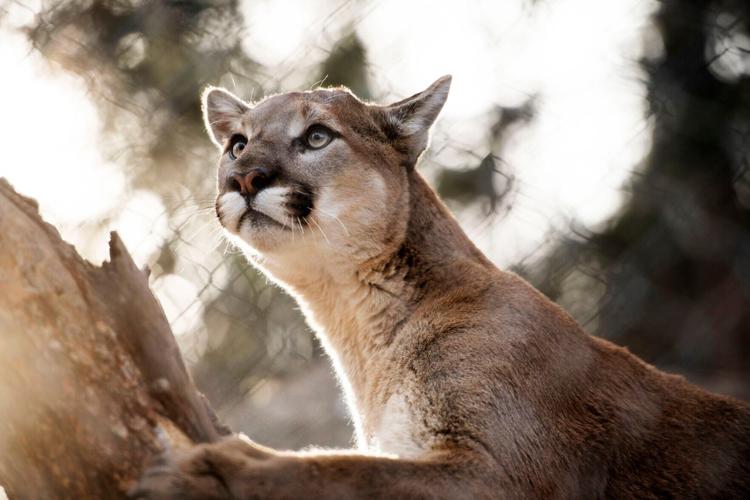Meet the mountain lions at Cheyenne Mountain Zoo. (Video by Skyler Ballard)
Poor Koda.
The 18-month-old mountain lion, who’s still considered a cub until he turns 2 this year, went and got his head stuck in a cardboard box again.
“Courtney to Rocky Mountain Highlands,” said Rocky Mountain Wild lead keeper Courtney Rogers into her walkie-talkie. “Koda is stuck in a box. We need the long pole from over by otters to get him out of it again.”
Welcome to another Tuesday in the mountain lion exhibit at Cheyenne Mountain Zoo.
You can’t really blame the young fella. After all, there were large hunks of raw pork chop inside the box. He was only trying to lick his plate.
Practicing patience: Meet the two-toed sloths at Cheyenne Mountain Zoo
“They get different forms of enrichment every day. Not always boxes,” Rogers said. “It’s anything we can give them to problem solve and figure out. This is the ultimate problem solving — this is some conflict resolution to get himself out.”
Koda doesn’t have to do much problem solving today, though, as Sitka, his 2-year-old brother, helps de-box him. Not necessarily on purpose, though. It was more that he was interested in the contents of the box than helping out his sibling.
Lounging nearby, Sitka’s 2-year-old sister, Adira, smugly watches the antics as she rips her own cardboard box into confetti. No head trapped in a box for this girl.
Sitka and Adira were found orphaned in Washington before landing at the zoo in 2019. Their duo became a trio when 5-month-old Koda, who was found wandering a logging road by himself in Washington, joined the gang in 2020.
And because he had no idea how to be a mountain lion when he got to the zoo, his first interaction was memorable.
“He ran at her (Adira) as fast as he could because he was so excited to be with her,” Rogers said. “He jumped onto her face and held on. She didn’t love it, so she ran away. It’s great — she was so much bigger and willing to run away from this little cyclone cub.”
Feed me, Seymour!
Rogers uses tongs to feed hunks of raw pork and balls of meat to Sitka through the metal fence. His white canines flash as he gobbles, and judging by his growls, he approves of his afternoon snacks.
“The better the piece, the louder his grumbles,” Rogers said. “Sometimes if a piece is really good, he’ll run away and eat it in private.”
The lions have no interest in your sweet potatoes and kale. They want meat, meat and more meat. Also bones and trout, which might be something a lion would go after in the wild. They also love goat’s milk, and when it comes time for an unpleasant husbandry task, they receive whipped cream afterward as a thank you for participating.
Large and in charge: Meet the hippos at Cheyenne Mountain Zoo
Stats, please
Sitka is a whopping 163 pounds, making him substantially larger than the normal 120-pound male lion. Koda clocks in at 110 pounds and Adira is 114. They tend to live into their mid to late teens, with females outliving the males.
A day in the life
A good day involves a lot of watching. In the late afternoons, the lions love to congregate on a heated rock at the top of their exhibit and either keep an eye on their keepers or Atka, the Alaska moose. They’re also big fans of Wolf TV, aka watching their Mexican wolf neighbors in their nearby exhibit. And don’t forget napping. These cats can sleep up to 20 hours a day, often in a cuddle puddle, especially best buddies Sitka and Koda.
Funny little kindergartners: Meet the African penguins at Cheyenne Mountain Zoo
Just giant housecats?
Cats have many similar behaviors across species, Rogers said. Mountain lions love a high spot to snooze, just like Sparkles does at home. They love warmth, which is why their exhibit has hot rocks and a heated cave. And they need to sharpen their claws, too, just not on a couch. They use logs. They purr, too, when they’re cuddled up together. And sometimes if a keeper purrs at them, they’ll purr back. Other large cats, such as lions and tigers, can only make a chuffing noise. Mountain lions can do both. They also make a chirping that sounds like a little bird to communicate with each other.
Nice to meet you
It’s rare to see one in the wild, Rogers said. If there is a case of a mountain lion attacking a human, it’s a starving cub or subadult who has lost their mom. Otherwise, lions in the wild start with small prey other animals don’t want, such as skunks and porcupines. Taking down a deer comes with big risks, such as getting kicked in the jaw or breaking a leg. Lions have to work their way up to the bigger creatures.
Contact the writer: 636-0270






















(0) comments
Welcome to the discussion.
Log In
Keep it Clean. Please avoid obscene, vulgar, lewd, racist or sexually-oriented language.
PLEASE TURN OFF YOUR CAPS LOCK.
Don't Threaten. Threats of harming another person will not be tolerated.
Be Truthful. Don't knowingly lie about anyone or anything.
Be Nice. No racism, sexism or any sort of -ism that is degrading to another person.
Be Proactive. Use the 'Report' link on each comment to let us know of abusive posts.
Share with Us. We'd love to hear eyewitness accounts, the history behind an article.